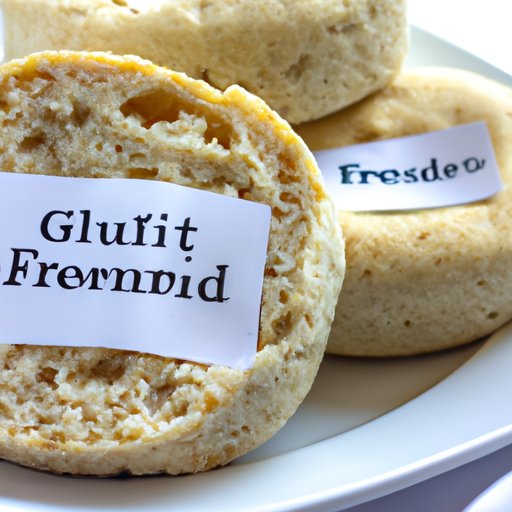
Introduction
English muffins are a beloved breakfast item that can be enjoyed in many different ways, from a classic bacon and egg sandwich to a modern avocado toast. But if you have a gluten sensitivity, you might be wondering if English muffins are a safe option for you. In this article, we will explore if English muffins contain gluten, what alternatives are available, and how you can make your own gluten-free English muffins at home.
Everything You Need to Know About English Muffins and Gluten-Free Eating
Gluten is a protein that is found in wheat, barley, and rye. For people with celiac disease or gluten sensitivity, consuming gluten can cause a variety of symptoms including abdominal pain, bloating, and diarrhea. Traditional English muffins are made with wheat flour and therefore contain gluten.
However, there are many gluten-free alternatives available for those who cannot consume gluten. These alternatives are typically made with a combination of gluten-free flours like rice flour, tapioca starch, or potato starch. Some brands also use alternative ingredients like almond flour or coconut flour.
The Best Gluten-Free English Muffins on the Market
If you’re looking for a pre-made gluten-free English muffin, there are many options available on the market. Some popular brands include Glutino, Udi’s, and Schar. Glutino has a classic English muffin that is praised for its soft texture and slight sweetness. Udi’s is known for its bread-like texture and is available in both white and whole-grain varieties. Schar’s English muffins are made with ancient grains like millet and sorghum and are popular for their dense texture and authentic taste.
When it comes to choosing a brand, it’s important to consider your personal taste preferences and dietary restrictions. It’s also important to note that pre-made gluten-free English muffins can be more expensive than conventional English muffins.
How to Make Your Own Gluten-Free English Muffins at Home
If you’re feeling adventurous, you can also make your own gluten-free English muffins at home. Here is a simple recipe:
- 1 1/2 cups gluten-free flour blend (rice flour, tapioca starch, and potato starch)
- 1/2 tsp xanthan gum
- 1/2 tsp salt
- 1/2 tsp sugar
- 1 tsp instant yeast
- 1 egg
- 1/2 cup milk (or dairy-free alternative)
- 3 tbsp unsalted butter (or dairy-free alternative)
1. In a large mixing bowl, whisk together the dry ingredients.
2. In a small pan, heat the milk and butter until the butter is melted. Allow to cool slightly.
3. Add the egg and milk mixture to the dry ingredients and mix until a dough forms.
4. Cover the bowl and allow the dough to rise for 1 hour.
5. Preheat a greased griddle or frying pan over medium heat.
6. Divide the dough into six equal portions and shape each into a ball.
7. Place the balls of dough onto the heated griddle or pan and flatten with a spatula.
8. Cook for 7-10 minutes on each side, until golden brown.
Your homemade gluten-free English muffins are now ready to enjoy!
Why Some English Muffins Contain Gluten and How to Avoid Them
The reason that conventional English muffins contain gluten is because they are typically made with wheat flour. Other ingredients like barley malt or rye flour can also contain gluten. If you are looking to avoid gluten, it’s important to read the ingredient list carefully and look for products that are labeled as gluten-free.
Gluten-Free Breakfast Ideas: English Muffins and Beyond
Now that you have your gluten-free English muffins, it’s time to enjoy them! Here are some creative ways to use them:
- Egg and cheese sandwich
- Avocado toast
- French toast casserole
- Benedict-style with hollandaise sauce
- Peanut butter and jelly sandwich
Tips for Finding Gluten-Free English Muffins in Your Local Grocery Store
Many grocery stores now offer a variety of gluten-free products, including English muffins. Look for them in the freezer section or the gluten-free aisle. Some key terms to look for on packaging include “gluten-free,” “wheat-free,” and “certified gluten-free.”
The Pros and Cons of Eating Gluten-Free English Muffins
One potential benefit of eating gluten-free English muffins is that they can provide an alternative for people with celiac disease or gluten sensitivity who may not be able to eat conventional English muffins. They also offer more variety in the breakfast options available.
However, some gluten-free products can be more expensive and less nutritionally dense than their conventional counterparts. It’s important to read the labels carefully and make choices based on your own nutritional needs and preferences.
Conclusion
English muffins are a classic breakfast item that can be enjoyed by people with a range of dietary needs. While traditional English muffins are not gluten-free, there are many alternatives available on the market or that can be made at home.




